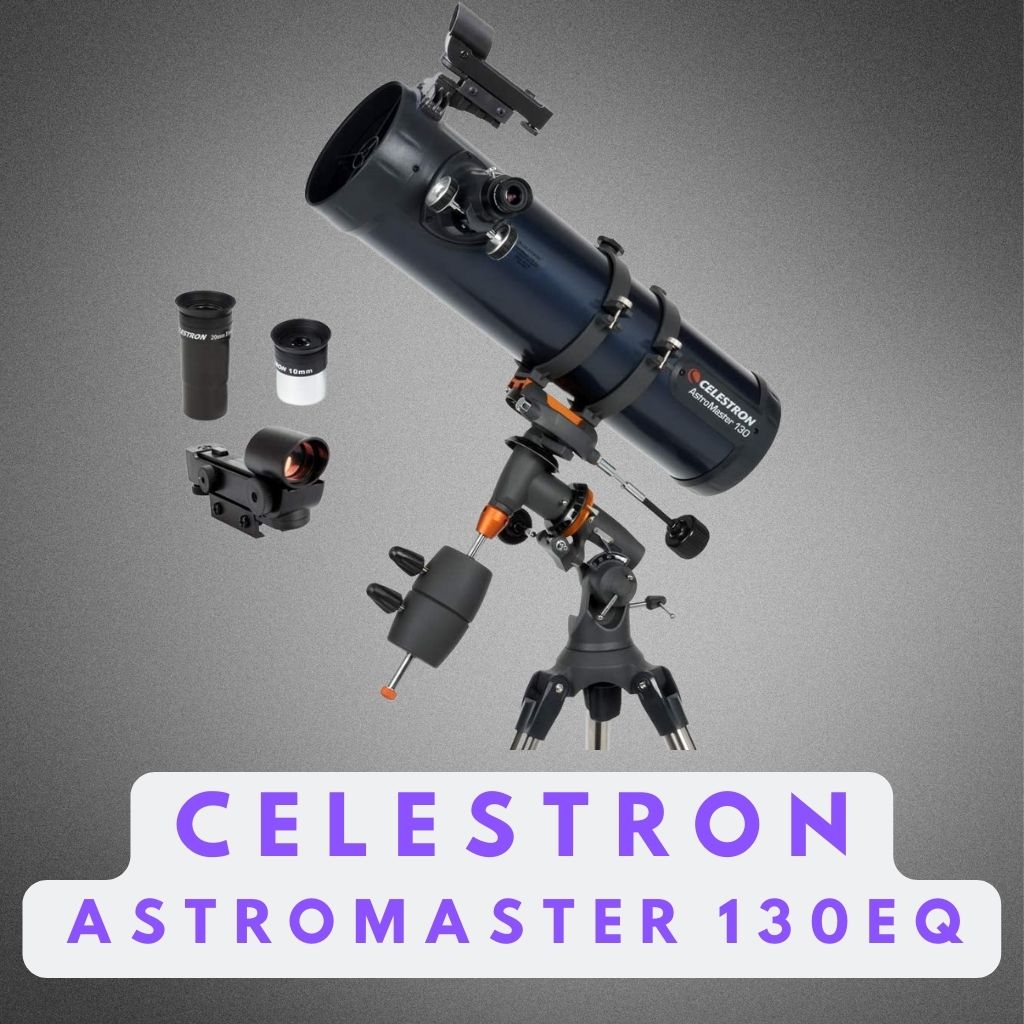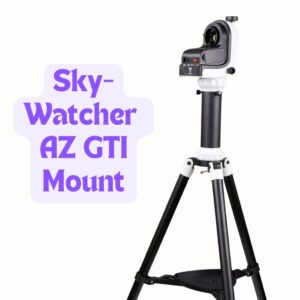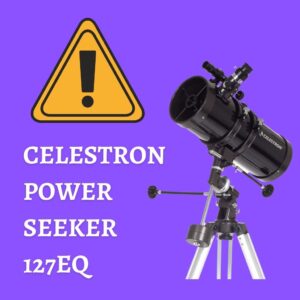This site contains affiliate links to products. I may receive a commission for purchases made through these links.
The Celestron Astromaster 130 EQ, with its user-friendly design and powerful optics, offers a great balance between affordability and performance. The telescope delivers crisp and clear images of astronomical objects. It comes with an equatorial mount, which makes it easy to track celestial objects as they move across the night sky.
The 130mm aperture of the telescope provides good light-gathering power, making it possible to see faint objects such as nebulae and galaxies.
In this article, we delve into the features that make the AstroMaster 130EQ a popular choice among beginners and intermediate astronomers.
Let’s begin!
What is in the Celestron Astromaster 130 EQ box?
Celestron Astromaster series telescopes are made as reflectors and refractors with different apertures (diameter) and mounts. The Celestron Astromaster 130 EQ is a Newtonian reflector telescope with a 130mm primary mirror, a focal length of 650mm, and a focal ratio of F/5.
When you unbox the Celestron Astromaster 130 EQ, you can expect to find several components necessary for setting up and using the telescope. Here’s a breakdown of what’s included in the box:
- Optical tube assembly (OTA) with mounting rings and dovetail bar
- Red dot finder
- Equatorial mount with a counterweight
- Lightweight steel legs
- Accessory tray
- 10mm and 20mm eyepieces
- Manual
- Starry Night astronomy software
Now, let’s do a quick review of a few of the components.
The Optical Tube Assembly (OTA) of Celestron Astromaster 130 EQ
The Optical Tube Assembly (OTA) of the Celestron AstroMaster 130 EQ is a crucial component, comprising a durable metal tube adorned with plastic elements at both ends and featuring preassembled mounting rings with a dovetail bar. The design of the OTA is aesthetically pleasing, showcasing an appealing color scheme that enhances its visual appeal. Additionally, it is equipped with adjusting screws for the primary mirror located at the tube’s end, essential for the telescope’s collimation.
Collimation, the process of aligning the optics of the telescope, is critical for achieving optimal focus and producing sharp, clear images. This process might be necessary upon initial receipt of the telescope and periodically during its use. While the idea of adjusting the mirrors may seem daunting, the process is straightforward, and numerous online tutorials are available to assist in this task.
A notable advantage of the AstroMaster 130 EQ is its provision for user collimation, setting it apart from other telescopes in its price bracket that often feature permanently affixed primary mirrors. This feature adds to the versatility and longevity of the telescope.
Furthermore, the telescope’s 1.25″ focuser is commendably constructed, with aluminum focusing knobs partially enveloped in rubber for improved grip and ease of use. Although it doesn’t accommodate 2″ eyepieces, the 1.25″ size is a widespread industry standard, offering a wide range of compatible eyepiece options. This thoughtful design consideration ensures that users have access to a variety of eyepieces to enhance their astronomical exploration.
You may also like: Refractor vs. Reflector Telescope (What Is The Difference)
The primary mirror of Celestron Astromaster 130 EQ
The primary mirror in Newtonian reflectors, such as the Celestron AstroMaster 130 EQ, is a critical component with a significant impact on the telescope’s performance. These mirrors are either spherical or parabolic in shape, but never flat.
Spherical mirrors are less expensive to manufacture but are prone to spherical aberration, especially in larger mirrors, affecting image clarity. Conversely, parabolic mirrors, which are free from spherical aberration, are considered superior in terms of image quality. They are particularly beneficial for larger apertures, but this comes at a higher cost.
Initially, the Celestron AstroMaster 130 EQ was equipped with a parabolic mirror, known for its superior image quality. However, in more recent models, Celestron has shifted to using spherical primary mirrors. This change likely reflects a strategic decision to reduce manufacturing costs, allowing the telescope to be priced more competitively, making it an attractive option for those new to astronomy.
While it’s possible to find older models with parabolic mirrors on the secondary market, new units of the AstroMaster 130 EQ now come with spherical mirrors. For beginners, the difference in image quality between these two mirror types at this aperture size may not be significantly noticeable, making the current version still a viable choice for entry-level astronomical exploration.
The focal ratio of Celestron Astromaster 130 EQ
With an aperture of 130mm and a focal length of 650mm, the AstroMaster 130 EQ has a focal ratio of F/5.
But what does this focal ratio imply for the telescope’s performance?
Essentially, the focal ratio is an indicator of the telescope’s “speed.” While the concept might seem complex, it can be simplified as follows: a telescope with a faster focal ratio, like F/5, captures brighter images compared to a slower one, say F/10. In practical terms, an image viewed through an F/5 telescope will be four times brighter than that seen through an F/10 telescope. This brightness advantage is particularly beneficial when observing dimmer celestial objects like nebulae and galaxies.
Therefore, with its F/5 focal ratio, the Celestron AstroMaster 130 EQ is especially well-suited for deep sky observations, enabling enthusiasts to explore fainter objects in greater detail and clarity.
The red dot finder of Celestron Astromaster 130 EQ
In the past, the Celestron AstroMaster 130EQ telescope featured a permanently mounted star finder, which received considerable feedback from users regarding its challenging usability and ineffectiveness in locating celestial objects. This aspect of the telescope often led to frustration among astronomers, especially those new to the hobby.
Recognizing this issue, Celestron has made a significant improvement by replacing the original star finder with a more user-friendly “red dot finder.” This new addition significantly enhances the telescope’s usability. The red dot finder works by projecting a dot onto a small glass screen, simplifying the process of aligning the telescope during daytime observations. To use it, one simply points the telescope at an object, peers through the red dot finder, and adjusts the dot until it aligns with the object seen through the eyepiece.
It’s important to note that after a night of stargazing, users should remember to switch off the laser to conserve battery life. Additionally, potential buyers should be aware that some vendors might still offer the older version with the fixed star finder. Therefore, it is advisable to specifically seek out models equipped with the red dot finder for a more user-friendly and efficient stargazing experience.
The Equatorial Mount (EQ) with steel legs of Celestron Astromaster 130 EQ
While it may not rank as the top mount in the market, Celestron has enhanced the appearance of this EQ2 mount, making it a viable option for basic visual observation of deep-space objects. Setting up and aligning the equatorial mount, known as polar alignment, might present a challenge for some, especially beginners. However, for basic use, it’s sufficient to simply face the mount north and adjust the latitude setting according to one’s location.
Balancing the telescope with a counterweight is also crucial for optimal operation. It’s important to note that the mount may exhibit some wobbliness. To counteract this, it’s advisable not to overly extend the legs and to add weight between them to lower the center of gravity. This additional weight should be placed on the central body of the mount where the legs converge, and not on an accessory tray, which might not support the extra weight.
Celestron’s decision to equip this telescope with metal legs deserves commendation, especially considering that many pricier telescopes come with aluminum legs, which may not offer the same level of stability. The inclusion of steel legs in a telescope at this price point is a significant advantage. The only minor drawback noted is the difficulty in reading the latitude scale due to the positioning of the needle, but this is a relatively minor issue in the overall context of the telescope’s design and functionality.
You may also like: Is A Cheap Telescope Worth It?
The motorized upgrade of Celestron Astromaster 130 EQ
The Celestron AstroMaster 130 EQ, while equipped with slow-motion adjustment knobs for right ascension and declination, can present challenges in keeping celestial objects in view due to the Earth’s rotation. However, there is an available upgrade that addresses this issue effectively.
This upgrade comes in the form of a simple clock motor. Once an object is centered in the viewfinder, activating this motor allows the telescope to automatically track the object, keeping it steadily in the center of the eyepiece. This automated tracking makes stargazing a more relaxed and enjoyable experience, eliminating the need for constant manual adjustments through the knobs while peering through the eyepiece.
It’s important to note that this motor is not included with the initial purchase of the telescope. However, it can be acquired separately as an add-on kit for those who already own the telescope.
Get the Celestron 31051 AstroMaster 130EQ MD on Amazon.
The 10mm and 20mm eyepieces of Celestron Astromaster 130 EQ
The Celestron AstroMaster 130EQ is packaged with two eyepieces, a 10mm and a 20mm, each contributing uniquely to the telescope’s observational capabilities.
The 10mm eyepiece, with its robust metal body, is designed to deliver a magnification of 65x when paired with the AstroMaster 130. This level of magnification is determined by dividing the telescope’s focal length (650mm) by the eyepiece’s focal length (10mm). Though it is of average quality, this eyepiece provides a clear and sharp view of celestial objects, making it suitable for detailed astronomical observations.
In contrast, the 20mm eyepiece is constructed with a plastic body and serves a different purpose. It is an erecting eyepiece, which means it is capable of presenting images in their correct orientation, making it ideal for terrestrial viewing during the day. Unlike standard eyepieces that invert images, the erecting design adds more optical elements, which can slightly reduce brightness when observing dim objects at night. Nonetheless, it still offers a decent viewing experience, particularly for observing the moon and other prominent celestial objects.
Celestron markets the AstroMaster 130EQ as a versatile, multipurpose telescope, a feature partly attributed to the inclusion of the 20mm eyepiece. While this adds to the telescope’s appeal, the actual benefit of this feature might differ based on the user’s specific needs and expectations.
Given the telescope’s affordable price, the included eyepieces provide satisfactory performance, though more serious enthusiasts might consider investing in higher-quality eyepieces or adding a Barlow lens to further enhance their astronomical experience.
The free starry night astronomy software included in the Celestron Astromaster 130 EQ box
Included as a bonus with the Celestron AstroMaster 130EQ is a CD containing the Starry Night Astronomy software, an invaluable tool for both beginners and seasoned astronomers. This software is particularly helpful for those looking to deepen their understanding of astronomy and for aiding in the identification and location of celestial objects in the night sky.
One of the standout features of Starry Night Astronomy software is its real-time sky projection. This function allows users to see a live representation of the sky, showing which celestial objects are currently visible and their precise locations. This feature can greatly enhance the stargazing experience, making it easier to plan observations and learn about different stars, planets, and deep-space objects.
The inclusion of this software with the AstroMaster 130EQ adds significant educational value, offering a more interactive and informative approach to exploring the cosmos.
You may also like: Is Celestron a Good Telescope Brand?
What can you see with a Celestron Astromaster 130EQ?
With the Celestron AstroMaster 130EQ, a telescope boasting a fast focal ratio of F/5, users can experience wide-field observations of the night sky. This characteristic makes it particularly suitable for viewing larger, more spread-out celestial phenomena rather than focusing on finer details of individual objects.
While the telescope can certainly be used to observe solar system objects like the moon and planets, its design and focal ratio mean that achieving highly detailed views of these objects might be more challenging compared to other telescopes optimized for such observations.
The 130mm aperture of the AstroMaster 130EQ is a significant feature, providing substantial light-gathering capacity, which is crucial for reflector telescopes. This capability allows for brighter and clearer images, especially under dark-sky conditions.
Additionally, with a maximum magnification potential of 307x, the AstroMaster 130EQ can gather light approximately 345 times more effectively than the naked eye. This impressive magnification and light-gathering ability make it well-suited for exploring a variety of deep-sky objects.
For observers looking to maximize their experience with this telescope, it’s recommended to focus on distant and expansive celestial subjects. These include star clusters, nebulae, intergalactic dust clouds, distant stars, and other galaxies. Such targets align well with the wide-field observational strengths of the AstroMaster 130EQ, offering a spectacular and rewarding viewing experience.
How to use the Celestron Astromaster 130 EQ?
Using the Celestron AstroMaster 130 EQ is a user-friendly experience, particularly suited for beginners. After unboxing, the telescope can be easily assembled following the provided instructions, which typically involves attaching the optical tube to the mount and then adding the finderscope and eyepieces. Its lightweight design enhances portability, making it convenient for transportation to various observing locations.
As a reflector telescope, it requires occasional collimation (alignment of the internal mirrors) to ensure optimal viewing clarity. The telescope comes with a manual equatorial mount, simplifying the process of locating celestial objects. By using the finderscope to first locate and center an object, users can then enjoy detailed views through the main eyepiece.
Is the Celestron Astromaster 130EQ a good telescope for beginners?
The Celestron Astromaster 130EQ is a decent telescope for beginners. It has a large aperture, which means it can gather a lot of light and provide detailed views of celestial objects such as the Moon, planets, and deep-sky objects like nebulae and galaxies.
The telescope is also relatively easy to set up and use. While it does require some assembly and alignment, the process is straightforward and can be learned quickly with the help of online tutorials.
So, is the Celestron Astromaster 130EQ worth it?
The Celestron Astromaster 130 EQ is absolutely worth it. It is a fully functional telescope that can serve you for many years, providing you with views of celestial objects like the moon’s craters, Jupiter’s bands, Saturn’s rings, and deep-sky objects such as galaxies, nebulas, and star clusters. Hence, it is a fantastic choice for beginners, especially with its affordable price point.
You can even explore basic planetary and moon astrophotography with a motorized drive upgrade. While the EQ mount may be more complex than an altazimuth mount, it’s still a great option for anyone planning to buy a telescope for kids 15 years or older.
Takeaway – A beginner’s guide to the Celestron Astromaster 130 EQ telescope
This Celestron Astromaster 130 EQ review clearly shows it is an excellent choice for amateur astronomers who want an affordable and easy-to-use telescope.
Although its short focal length enables it to perform best in planetary viewing, its 650mm focal length and 130mm aperture allow it to provide crisp, clear images of the moon, stars, and planets.
One of the best things about the Astromaster 130 EQ is its ease of use. It is simple to set up and comes with a StarPointer red dot finder and Starry Night Astronomy software. The Starry Night Astronomy software helps you learn more about astronomy and makes locating objects in the night sky easy.
Whether you are a beginner or an experienced stargazer looking to experience the wonders of the night sky, the Celestron Astromaster 130 EQ is an excellent choice for exploring the cosmos.
Don’t forget to subscribe to our newsletter where you’ll find the latest cosmic discoveries, expert stargazing tips, and exclusive subscriber deals. Embark on your cosmic journey if you haven’t already!
You may also be interested in:






